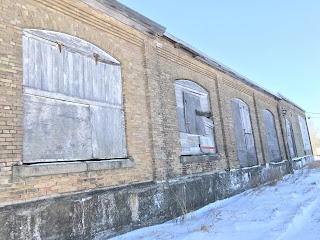Is there a phrase more often said? In areas where the postal system is not delivered to your door as in Reston, it is self serve. Mail was one of the first services established in any new settlement to keep in touch with those the pioneers left behind. Receiving news from letters and newspapers was vital communication in the days before instant communication the way we have it now.
The first Reston post office was established in 1890 on the farm of William Bulloch. Once the town was established where it is today, the post office relocated to a building on third street and then moved to the former Harris Boarding house (with the yellow star above) on the south end of Fourth Street. A fire in May of 1915 claimed this post office and it was thought also $5000 in cash that was destined for the bank. An earlier blog post here tells that the Pinkerton Detectives got to the bottom of that case. Dr. Stevenson's former vet office was the next location and there was talk of building a new post office. Gordon Goldsborough covered the topic of Post Office buildings in his Abandoned Manitoba radio show and you can listen here. As was the case for smaller centers, leasing a building for the post office happened instead of building. Brady's Hardware which is now the Martin Block, gave the post office a home for the next many decades.
Reston saw a major building renewal in the 1960’s with the high school(1961), rink (1964), hotel and gas station (1966), co-op hardware store (1965) and elementary school (1967). It was decided that something more convenient and modern was needed and the new post office was officially opened on September 25, 1964. The grand event was attending by many dignitaries and the official opening of the new water and sewer system was held the same day.
 |
| Ribbon ready to be cut on opening day 1964 - From McKee Archives at Brandon University |
Day in and day out, the post office becomes the place to check the box and visit with a neighbour doing the same. A news story from 2000 indicates 168 new mailboxes were installed to give a total of 536 boxes. Post offices have seen a shift in services from letters, bills moving to online email delivery but shipment of parcels has taken off. Online companies like Amazon, Walmart and others have found their customers through their keyboards. Add Christmas gift mailing into the Covid-19 pandemic and the post office parcel surge was massive.
Reston has had some long term postmasters over the years.
- William "Bill" or "Mac" Harkness Mc Dougall was first from 1893 until 1928. Mac was an accomplished curler and community supporter. He and his wife Etta Burge had at least 3 sons and a daughter. In 2002, Fletch Manning wrote an article about their home in Reston and you can read it here.
- Wesley George Morris was raised by his grandmother Mrs. Adaline Armstrong of Reston. He was postmaster from 1929 to 1943 and did not have an easy time in life after losing a leg in battle in 1918 at Kemmelberg, Belgium. He bought the former Methodist church and had it converted to a dwelling.
- Cyril Standring was in charge from 1944 - 1955. He was a soloist of note in the choir of Reston United Church and led the choir for many years.
- Oliver Chester was postmaster from 1955 to 1980. He had spent 5 years overseas with the Princess Pats and worked as a grain buyer on his return before the post office. He and his wife Velma Addison raised 3 children. He was an active curler, community, sports and Elizabeth Legion member.
- Gary McElheron and Jeff Kirk followed for several years each.
- Current postmaster Candice Morris is no different, working here since 1982.
- Several more filled the position in an acting capacity (including Aunt Jean (Boulton) Elliott) and others were hired as assistants.

























